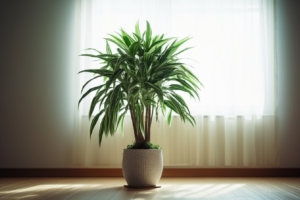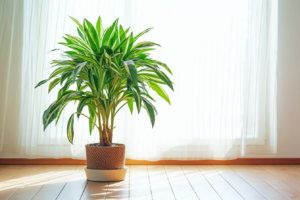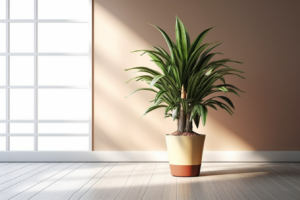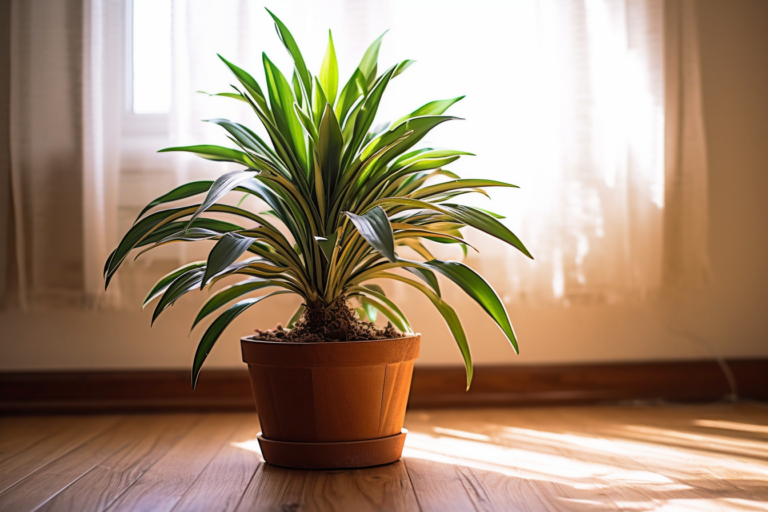Dracaena plants are a popular choice for home and office décor. With over 50 different species, these plants come in a variety of shapes, sizes, and colors, making them a versatile option for any interior setting. However, many plant owners may struggle with determining the proper watering schedule for their dracaena.
The frequency of watering a dracaena plant largely depends on factors such as the species of plant, the size of the pot, and the environment in which it is located. While some dracaena species prefer a consistently moist soil, others may only need watering every few weeks. It’s important to consider these factors and to observe the plant for signs of dehydration or overwatering. By following a few simple guidelines, it is possible to establish a watering routine that will keep your dracaena plant healthy and thriving for years to come.
Factors Affecting Dracaena Watering Needs
Watering a dracaena can sometimes be tricky, as it’s important to find the right balance between too much and too little water. There are several factors that can affect how often you’ll need to water your dracaena, including:
Type of Dracaena
There are many different types of dracaena, each with their own specific watering needs. For example, the Dracaena reflexa has a higher tolerance for dry soil and can go longer between waterings than the Dracaena fragrans. It’s important to do your research and identify what type of dracaena you have, so you can determine the best watering schedule for it.
Lighting Conditions
The amount of light your dracaena receives can also impact how often it needs to be watered. Plants that receive more light generally require more water than plants that are in low light conditions. Additionally, if your dracaena is in direct sunlight, it may require more frequent watering due to evaporation.
Humidity Levels
Dracaenas prefer humid environments, so if you live in a dry climate or have dry indoor air, you may need to water your dracaena more frequently. Using a humidifier or placing a tray of water near the plant can help maintain the necessary humidity levels.
Pot Size and Drainage
The size of the pot and the drainage holes can also affect how often you need to water your dracaena. A smaller pot will dry out faster than a larger pot, while pots without drainage holes can lead to waterlogged soil and root rot.
Temperature
Extreme temperature changes can affect how often you should water your plant. In warmer weather, your dracaena may need to be watered more often, while in colder weather, it may require less frequent watering.
By taking these factors into consideration, you can make an informed decision on how often to water your dracaena. Remember to always check the soil moisture level before watering and adjust your schedule as necessary.
Signs of Overwatered Dracaena:
When it comes to watering a dracaena, finding the right balance between not enough water and too much water can be a challenge. Overwatering can be especially harmful to dracaenas, as they are susceptible to root rot and other issues related to excess moisture. Here are some signs that your dracaena may be receiving too much water:
Yellow Leaves
A common sign that your dracaena may be receiving too much water is yellow foliage. As the roots of your dracaena become waterlogged, they may begin to rot, causing the leaves to yellow and eventually turn brown.
Brown Tips
Another sign of overwatering in dracaenas is brown tips on the leaves. This is usually an indication that the plant is struggling to absorb all the water it’s receiving.
Soft, Saggy Stems
If the stem of your dracaena feels soft and saggy to the touch, this is indicative of overwatering. The excess moisture in the soil can cause the stem to become mushy and weak, which can ultimately lead to the plant’s decline.
Mold or Mildew
Finally, if you notice any mold or mildew growing on the soil or around the base of the plant, this could be a sign of overwatering. These fungal organisms thrive in moist environments, so if your dracaena is receiving too much water, they can quickly take over.
It’s important to note that these signs can also be indicative of other issues, so it’s crucial to properly identify the cause of the symptom before taking action. In general, if you suspect that your dracaena is overwatered, it’s important to let the soil dry out completely before watering it again. It may also be necessary to repot the plant in fresh soil to avoid root rot and other issues related to excess moisture.
Signs of Underwatered Dracaena
Dracaenas are a type of houseplant that require consistent watering to maintain their health and appearance. If you notice your dracaena starting to look a little sad, it could be a sign that it’s not getting enough water. Here are some signs that your dracaena may be underwatered:
- Drooping leaves: One of the most obvious signs of underwatering in a dracaena is drooping or curling leaves. When a dracaena doesn’t get enough water, its leaves will start to wilt and look dry.
- Brown leaf tips: Another sign of underwatering is brown, crispy tips on the leaves. This indicates that the plant is not getting enough water to support healthy growth.
- Slow growth: If your dracaena seems to have stalled in its growth, it could be due to lack of water. The plant needs a consistent supply of moisture to be able to grow properly.
- Dry soil: A surefire sign that your dracaena needs water is dry soil. Before you water your plant, check the soil with your finger. If it’s dry to the touch, it’s time to give your dracaena a drink.
If you notice any of these signs, it’s important to start watering your dracaena more frequently. However, be careful not to overwater your plant, as this can lead to other issues. Check the soil regularly and adjust your watering schedule as needed to keep your dracaena happy and healthy.
Watering Frequency for Indoor Dracaena
Proper watering is essential to maintaining the health of your indoor dracaena plant. As a general rule, dracaena plants don’t need frequent watering since they are drought tolerant, but not watering them often enough can cause leaves to drop and damage the plant. In this article, I’ll discuss how often you should water your indoor dracaena plant to keep it healthy and thriving.

How Often to Water Your Dracaena?
The frequency with which you should water your indoor dracaena plant will vary depending on a few key factors, including the size of the pot, the type of dracaena you have, and the environmental conditions it is exposed to. On average, you should aim to water your dracaena plant once every two weeks.
Signs That Your Dracaena Needs Watering
It’s important to keep an eye on your dracaena plant to ensure that it is not underwatered or overwatered. Signs that your dracaena plant needs watering include leaves turning yellow or brown, leaves drooping or curling, or the soil feels dry to the touch. If you notice any of these signs, it’s time to water your plant.
Tips for Watering Your Dracaena

When watering your dracaena, it’s important to choose a well-draining potting mix and allow the soil to dry out between watering sessions. You should also ensure that the pot has adequate drainage holes to prevent water from accumulating in the bottom of the pot. When watering your plant, pour water slowly at the base of the plant until water comes out of the drainage holes.
Conclusion
In conclusion, proper watering is essential to maintaining the health of your indoor dracaena plant. Make sure to follow the guidelines outlined in this article, and pay attention to signs that your plant is in need of watering. Watering your plant once every two weeks and choosing a well-draining potting mix will go a long way in keeping your dracaena healthy and thriving.
Watering Frequency for Outdoor Dracaena
When it comes to watering outdoor dracaena plants, there are a few factors to consider. The frequency of watering will depend on the climate, humidity, soil type, and the age and size of the plant. Here are some guidelines to keep in mind:

Climate
If you live in a dry or hot climate, your outdoor dracaena will require more frequent watering. In contrast, if you live in a cooler or more humid climate, you can water less frequently. Be sure to monitor the soil moisture level and adjust your watering schedule accordingly.
Soil Type
Dracaena plants prefer well-draining soil that is rich in organic matter. If your soil is heavy or clay-like, it may retain water for longer periods of time, which can lead to root rot. In this case, you’ll need to water less frequently to prevent overwatering. On the other hand, if your soil is sandy or porous, it may dry out more quickly, so you’ll need to water more often.
Size and Age of the Plant
Young or recently transplanted dracaena plants will require more frequent watering as they establish their roots. Once they have matured, they will be able to tolerate longer periods of drought. Additionally, larger plants will require more water than smaller plants.
Guidelines
As a general rule, outdoor dracaena plants should be watered when the top inch of soil is dry to the touch. This can range anywhere from once a week to once every three weeks, depending on the factors mentioned above. It’s important not to overwater, as this can lead to root rot and other issues.
To ensure proper watering, be sure to also check the soil pH and fertilize your dracaena plant according to its specific needs. With proper care, your outdoor dracaena will thrive and add beauty to your outdoor space.
Dracaena Watering Techniques
When it comes to watering your dracaena plants, you don’t want to overdo it or underwater them. Both can lead to issues, such as root rot or dehydration. So, how often should you water your dracaena plants? Here are some watering techniques to help keep them healthy:
Check the soil moisture
Before you water your dracaena, it’s important to check the soil moisture level. Stick your finger about an inch into the soil. If it feels dry, it’s time to water. If it still feels moist, hold off for a few days and check again.
Use room temperature water
Dracaenas prefer room temperature water. If the water is too hot or too cold, it can shock the roots and lead to problems.
Water thoroughly, but don’t let it sit in water
When you water your dracaena, make sure to water thoroughly so that the water reaches the roots. But, you don’t want the plant to sit in excess water, as this can lead to root rot. Make sure the pot has drainage holes and remove any excess water that collects in the saucer.
Adjust watering frequency depending on environment
The frequency of watering your dracaena plants will depend on the environment where you keep them. If they are in a humid environment, they may require less water. Alternatively, if they are in a drier environment, they may need to be watered more frequently.
By following these watering techniques, you can ensure that your dracaena plants stay healthy and thrive in their environment.
Best Watering Practices for Dracaena
When it comes to watering your dracaena, there are a few best practices to keep in mind. Here’s what I recommend:
Water when the top inch of soil is dry
Before watering your dracaena, check to see if the top inch of soil is dry. If it’s still moist, hold off on watering for a bit longer. Overwatering can be a common cause of problems for dracaenas, so it’s important to make sure the soil is truly dry before adding more water.
Use room-temperature water
Dracaenas prefer room-temperature water (between 65-75°F) for watering. Avoid using water that is too cold or too hot, as this can shock the plant’s roots and cause damage.
Water thoroughly
When you do water your dracaena, be sure to water it thoroughly. This means pouring water into the pot until it begins to drain out of the bottom. This helps ensure that the roots are evenly moistened.
Avoid standing water
Dracaenas prefer moist soil, but they don’t like to sit in standing water. After watering, be sure to empty any excess water out of the saucer beneath the pot to prevent the roots from becoming waterlogged.
Adjust watering based on season
In the warmer months, your dracaena may need to be watered more frequently due to increased evaporation and higher levels of growth. In the cooler months, you can reduce watering frequency as the plant’s growth slows down.
Remember, it’s always better to under-water than over-water your dracaena. With these best practices, you can help ensure that your plant stays healthy and happy.
Thanks for the reminder! Here’s the requested section on “How to Check Soil Moisture for Dracaena”:
How to Check Soil Moisture for Dracaena
Checking the soil moisture level of your dracaena is an important step in determining when it’s time to water your plant. Here are some simple steps to take to check your dracaena’s soil moisture:
- Start by inserting your finger about an inch into the soil around the base of the plant. Be sure to do this in multiple spots around the plant so you get an accurate idea of the moisture level.
- If the soil feels dry to the touch, it’s time to water your dracaena. However, if the soil feels moist or wet, wait a few more days for the soil to dry out before watering.
- Alternatively, you can use a moisture meter to check the soil moisture level of your dracaena more accurately. Simply insert the prongs of the meter into the soil and read the moisture level on the meter’s display.
It’s important to note that overwatering your dracaena can cause root rot and other plant health issues, so it’s always better to err on the side of caution and let the soil dry out between watering sessions. By regularly checking your dracaena’s soil moisture, you can ensure that you are providing the optimal amount of water for your plant’s needs.
Tips for Maintaining Dracaena Health
When it comes to maintaining the health of your dracaena, there are a few things to keep in mind in addition to watering frequency. Here are some tips to help you keep your dracaena happy and healthy:
- Provide adequate light: Dracaenas prefer bright, indirect light. Place your plant near a window, but avoid exposing it to direct sunlight as this can scorch the leaves.
- Keep the humidity level constant: Dracaenas thrive in a moderate to high humidity environment. Consider using a humidifier or placing a tray filled with pebbles and water under the plant to increase humidity.
- Dust the leaves regularly: As with most houseplants, dust can accumulate on the leaves of your dracaena. This can interfere with its ability to photosynthesize. Wipe down the leaves periodically with a soft, damp cloth to remove dust and keep the leaves healthy.
- Fertilize occasionally: Dracaenas don’t require frequent fertilization, but it can benefit the plant to apply a general-purpose houseplant fertilizer every 2-3 months during the growing season (spring and summer).
- Watch for pests: Check your dracaena regularly for signs of common houseplant pests such as spider mites, mealybugs, and scale insects. These pests can weaken your plant and make it more susceptible to disease. If you notice any pests, take action to eliminate them using an insecticidal soap or neem oil.
By following these tips, you can ensure that your dracaena remains healthy and vibrant for years to come. Remember, different species of dracaena may have slightly different care requirements, so always do your research to determine the specific needs of your plant.
Here is the conclusion to the article on “how often to water dracaena”:
Conclusion
In conclusion, caring for your dracaena plant can be a rewarding experience. However, it’s important to understand that not all plants require the same amount of water, and over- or under-watering can be detrimental to their health.
Here are some key takeaways to keep in mind:
- The frequency of watering your dracaena plant will depend on various factors such as the type of plant, soil type, humidity, and sunlight exposure.
- Over-watering can lead to root rot and other fungal diseases, while under-watering can cause the leaves to turn brown and wilt.
- It’s important to check the soil before watering and only water the plant when the soil is dry to the touch, but not bone dry.
- It’s better to under-water than over-water, and you can always increase the frequency of watering if you notice your dracaena is drying out.
By following these guidelines and paying close attention to the needs of your dracaena plant, you can ensure that it remains healthy and vibrant for years to come. Remember to always be patient and observant when caring for your plants. Happy growing!
FAQS
Can I use tap water for my dracaena plant?
Yes, you can use tap water for your dracaena plant. However, if your tap water has a high level of salts or chlorine, consider using filtered or distilled water instead.
Do dracaena plants require more frequent watering during the warmer months?
Yes, dracaena plants may require more frequent watering during the warmer months due to increased evaporation and transpiration. Monitor the soil's moisture level closely and adjust your watering schedule accordingly.
How can I tell if my dracaena plant needs repotting?
Signs that your dracaena plant needs repotting include roots growing out of the drainage holes, slow growth, and a decline in overall health. When repotting, choose a pot that is one size larger than the current one and use a well-draining soil mix.
Can I mist my dracaena plant instead of watering it?
Misting your dracaena plant can help increase humidity around the plant, but it is not a substitute for proper watering. Dracaena plants need consistent moisture in their soil to maintain optimal health.
Do different dracaena species have different watering requirements?
While the general watering guidelines outlined in this article apply to most dracaena species, some species may have specific requirements. Always research your specific dracaena species to ensure you're providing the best possible care.


Thanks for sharing this helpful guide on how often to water dracaena plants, both indoor and outdoor. I have struggled with keeping my dracaena healthy in the past, but now I know to check the soil moisture level and water when it is dry to the touch. Your advice on using filtered or distilled water is also appreciated. Keep up the good work!